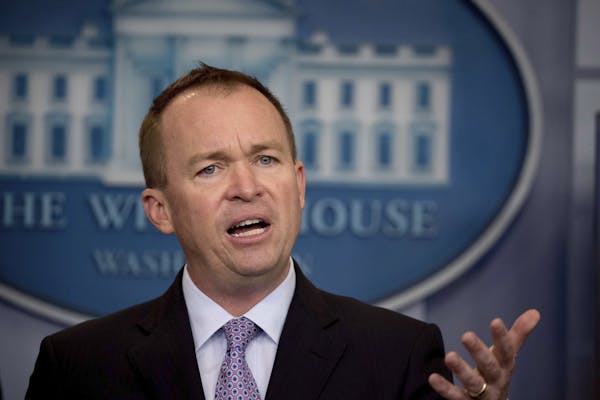The White House released more details of its federal budget proposal. It includes substantial cuts to Medicaid and other aid to the poor. Because it comes packaged with tax cuts, it assumes the economy will grow faster as a result and ultimately balance the budget by 2027. It is, however, unlikely to pass Congress as is.
Total spending cuts: $4.3 trillion over 10 years
Nondefense discretionary spending: $1.4 trillion
As outlined in March's "skinny budget," the proposal includes significant cuts to most nondefense government agencies. The Environmental Protection Agency would be cut by 31 percent for 2018 and the State Department and related programs by 29 percent, with additional 2 percent cuts each year after. Law enforcement and homeland security spending are exceptions — the budget includes $1.6 billion for a border wall.
Medicaid and the Children's Health Insurance Program: $616 billion
Changes to Medicaid and the Children's Health Insurance Program would save the federal government money, but would reduce the number of people with insurance. Medicaid savings are estimated at $610 billion over 10 years. The administration would shift some costs to the states, by setting annual limits on federal payments to each state, starting in 2020.
Claimed savings from reductions in war funding: $593 billion
Phasing down the Defense Department's Overseas Contingency Operations fund, an off-budget spending account that is used to fund wars, saves some more money. The fund has been used to override spending caps passed by Congress and could be changed during any given year.
Other: $339 billion
The budget includes new limits on medical malpractice lawsuits, expected to reduce the practice of "defensive medicine," saving Medicare $31 billion over 10 years. It also proposes raising about $36 billion in new federal revenue by selling off major American energy resources and infrastructure, opening up vast new areas of public land for oil and gas drilling, and redirecting state revenues that flow from oil and gas royalties back to Washington. The Postal Service would see $46 billion in cuts.
Savings on interest payments on the debt: $311 billion
Interest payments on the federal debt are one of the federal government's biggest expenses. Under current law, the interest payments are expected to grow as deficits mount and interest rates increase. The Trump administration predicts that its cost-cutting will slow this rise.
Welfare programs: $272 billion
The budget seeks to cut the Supplemental Nutrition Assistance Program, which provides food stamps, by $190 billion and the Temporary Assistance for Needy Families block grants by $15.6 billion. It also proposes $40 billion in savings by barring unauthorized immigrants from collecting the child care tax credit or the earned-income tax credit.
Repeal and replace Affordable Care Act: $250 billion
Undoing the Affordable Care Act would save $250 billion over 10 years, according to the Trump administration, which promises "a smooth transition away from Obamacare." (These savings are in addition to those proposed for Medicaid.)
Student loans: $143 billion
The Trump administration is proposing large cuts to the federal student loan program for low-income college students. The proposal eliminates federally subsidized loans, which pay students' loan interest while they are in school, saving $39 billion. The budget would also eliminate the public service loan forgiveness program for nurses, police officers and teachers. The largest savings, about $76 billion, would come from creating a single student loan repayment plan based on income.
Government payments: $142 billion
The budget promises savings from reducing unspecified government payments through "actions to improve payment accuracy and tighten administrative controls."
Disability programs: $72 billion
The budget would tighten access to Social Security's disability program, counting $48 billion in savings from testing "new approaches to increase labor force participation." The budget does not make changes to Social Security benefits for retirees, which along with Medicare is one of the primary drivers of the nation's debt.
Retirement benefits for federal employees: $63 billion
Cutting retirement benefits to federal workers would save $63 billion over 10 years. It would be done by reducing the cost-of-living adjustment for retirees and by gradually increasing government employees' contributions to their own retirement fund.
Farm bill programs: $38 billion
Trump is proposing a cap on crop insurance premium subsidies and eliminating commodity payments and crop insurance for farmers with adjusted gross income above $500,000 a year.
Financial regulation: $35 billion
Unspecified changes to the Dodd-Frank Act passed after the financial crisis of 2008 would produce more savings.
Spending Increases: $717 Billion Over 10 Years
Discretionary defense spending: $469 billion
Trump is proposing a roughly 10 percent increase to the Pentagon's base budget, with some of the money going toward new jets for the Air Force and ships for the Navy. The increase goes hand in hand with Trump's proposal to cut foreign aid, including programs that military officials say contribute to global stability and are seen as important in avoiding future conflicts.
Infrastructure investment: $200 billion
The $1 trillion infrastructure program is now called a private/public infrastructure investment, priced at $200 billion over 10 years.
Veterans Choice Program: $29 billion
The budget would extend a voucherlike program that allows veterans to seek medical care in private hospitals outside the Veterans Affairs system.
New paid parental leave program: $19 billion
A new program would provide six weeks of paid leave to new parents.
Claimed savings from economic growth: $2 trillion
The bulk of the savings in Trump's budget come from "economic feedback" effects. The administration is projecting that its tax cuts and changes to welfare programs will spur significant economic growth and expand the workforce, resulting in $2 trillion more in revenue than would have been generated under current law. The economy would need to grow at least 3 percent per year, a pace most economists say is unrealistic.
New York Times
